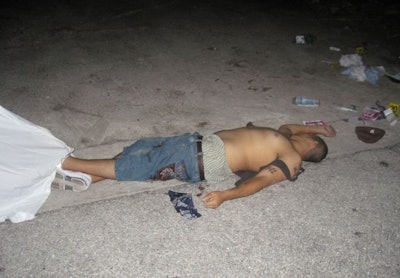 Photo courtesy of Ben Pieper.
Photo courtesy of Ben Pieper.
I started my law enforcement career with the Bradenton (Fla.) Police Department in 2003. I am an original member of the department's gang unit, which was established in 2005. I have interviewed and documented hundreds of gang members, investigated thousands of gang-related crimes from simple violation of probation to murders, and been involved in several state level Racketeer Influenced and Corrupt Organizations (R.I.C.O.) cases. If there's one thing that I've learned it's that motivation for crime doesn't change. Gang members of all ages desire three things: money, power, and respect. And they'll get it by any means necessary.
While their motivation hasn't changed, the means by which gang members commit their crimes has changed over the years just as the technology that makes it easier for them to commit the crimes has changed.
As law enforcement officers, we are constantly chasing and playing catch up to these criminals and how they're committing crime. And just as these gang members are finding new and innovative ways to commit crime, they're also finding new ways to conceal their criminal activity and identification from us.
Nationwide gangs have opened up their ranks; many gangs are not race or sex specific anymore. We are not just dealing with Bloods, Crips, Latin Kings, or Gangster Disciples. We are now dealing with non-traditional or hybrid gangs running our streets, and they are vying for the controlling stakes of the illicit profits that gangs use to gain control of the communities that we took an oath to serve and protect.
Currently, U.S. Code defines a criminal street gang as an ongoing group, club, organization, or association of five or more persons that has as one of its primary purposes the commission of criminal offenses. The members of a gang engage or have engaged in a continuing series of offenses within the past five years.
Note that nowhere in official definition is there a mention of race, sex, or age.
Law enforcement has spent decades investigating criminal street gangs and their members, constantly looking for new ways to eliminate these organizations. Over the years the gang members have gotten smarter or at least figured out ways to hide their gang affiliation from us.
If members of the Bloods gang realize that we know they use red bandannas to identify themselves, then they are likely start to start wearing a pink bandanna or just not wear any bandanna. Or perhaps they'll wear their shoe laces a certain way or something of that nature to identify themselves with a gang and still be able to hide their gang affiliation from law enforcement.
Fortunately, media such as MTV, VH1, BET, and Facebook have made it easier for us to follow and document how and what the gang members are doing to represent their affiliation.
Unfortunately, media exposure is also one of the reasons that the gangs are changing their colors, names, and symbols at such a rapid rate. Another reason is that they realize that we are documenting this information.
This is where we as law enforcement officers and prosecutors tend to have trouble. We have spent nearly 50 years dealing with the infamous Bloods criminal street gang that originated in California. The Bloods were traditionally an African-American gang that wore red and black.
So imagine if in your town, you begin to see more than three individuals of various racial and ethnic backgrounds that are always hanging out together wearing football jerseys and orange bandannas. You also note a pattern where members of your local agency have arrested these individuals several times each for charges, including weapons violations, narcotics, car thefts, and assault and battery. Furthermore, the members of the group call themselves the Orange Street Boomerang Bloods.
Nationwide, gang officers are seeing this problem of non-traditional and/or hybrid gangs. Sometimes these gangs will take on the name of a traditional gang such as the Bloods, Crips, or Latin Kings. But they won't have any actual identifiers with that gang, other than the name. We're seeing hybrid gangs pop up all over the country. These gangs can be very hard to document, due to the fact that they may not have any national affiliation, and their names are usually taken from the street, city, town, or neighborhood where they live. These groups are also known to change their names often and have little or no rank structure. Whoever has the most money, guns, and drugs has the most power.
For law enforcement officers and prosecutors, it is important to remember that no matter what a criminal gang wants to call itself, we track, document, and prosecute it. We also have to remember that these gangs are no less dangerous than the longstanding traditional gangs. In fact traditional gangs will often align themselves with our local non-traditional or hybrid gangs and work together to conduct criminal activity. So when working a case to try and takedown one of these gangs, we should work it the exact same way as if we were working a traditional gang, by building a strong prosecutable case.
Ben Pieper is a detective with the Bradenton (Fla.) Police Department, assigned to the Gang Unit.














